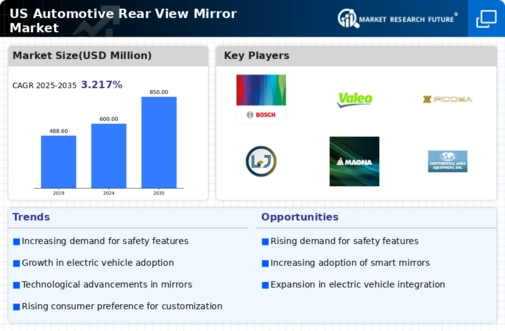Increased Focus on Aesthetic Appeal
Aesthetic considerations are becoming increasingly important in the automotive rear-view-mirror market. Consumers are now looking for mirrors that not only serve functional purposes but also enhance the overall design of their vehicles. This trend is particularly evident in the luxury car segment, where sleek and stylish rear-view mirrors are in high demand. Market data suggests that the luxury automotive segment is expected to grow by 10% annually, driving the need for aesthetically pleasing rear-view mirrors. As manufacturers strive to meet these consumer preferences, the automotive rear-view-mirror market is likely to evolve, incorporating design elements that appeal to a broader audience.
Growth of the Electric Vehicle Segment
The rise of electric vehicles (EVs) is influencing the automotive rear-view-mirror market significantly. As EVs often feature advanced technology and design, the demand for innovative rear-view mirrors that complement these vehicles is increasing. For instance, many EVs are equipped with digital rear-view mirrors that provide a wider field of view and eliminate blind spots. This trend is expected to contribute to a market growth rate of 12% over the next five years. The automotive rear-view-mirror market is likely to see a surge in demand as manufacturers align their products with the evolving needs of the electric vehicle segment.
Rising Consumer Demand for Enhanced Visibility
Consumer preferences are shifting towards products that offer improved visibility and functionality. The automotive rear-view-mirror market is responding to this demand by introducing mirrors with features such as auto-dimming and integrated cameras. These enhancements not only provide better visibility during night driving but also assist in parking and maneuvering. Market analysis indicates that the segment for mirrors with integrated cameras is projected to grow by 15% annually, reflecting a significant shift in consumer expectations. As drivers seek more versatile and functional rear-view mirrors, manufacturers are likely to invest in research and development, further propelling the automotive rear-view-mirror market.
Technological Advancements in Automotive Safety
The automotive rear-view-mirror market is experiencing a notable shift due to advancements in safety technologies. Innovations such as blind-spot detection and lane departure warnings are increasingly integrated into rear-view mirrors, enhancing driver awareness and reducing accidents. According to recent data, the incorporation of these technologies has led to a 20% decrease in rear-end collisions in the US. As consumers prioritize safety features, manufacturers are compelled to adapt their products, driving growth in the automotive rear-view-mirror market. This trend suggests that the demand for mirrors equipped with advanced safety features will continue to rise, potentially leading to a market expansion of approximately $1 billion by 2027.
Impact of Regulatory Changes on Design Standards
Regulatory changes are playing a crucial role in shaping the automotive rear-view-mirror market. New safety regulations are being implemented, requiring manufacturers to enhance the design and functionality of rear-view mirrors. For instance, the National Highway Traffic Safety Administration (NHTSA) has introduced guidelines that mandate improved visibility standards for rear-view mirrors. Compliance with these regulations is essential for manufacturers, as non-compliance could result in significant penalties. This regulatory environment is expected to drive innovation and investment in the automotive rear-view-mirror market, as companies seek to develop products that not only meet but exceed these new standards.


















Leave a Comment